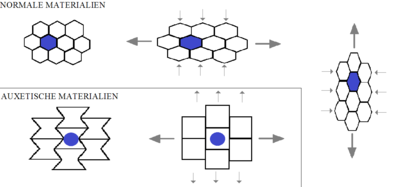
Auxetics are typical structures of the representative mechanical meta-materials. Mechanical meta-materials are structures whose mechanical properties are artificially derived from sophisticated structures and refer to unique structures that do not take place in nature. Herein, the basic concept of meta (meta means beyond in Greek) implies something that goes beyond naturally occurring substances. Generally, materials have a positive Poisson's ratio. Unlike general materials, Auxetics are structures or materials that have a negative Poisson's ratio. In terms of general materials, it is noted that while elongating along the x axis, the length in the y axis is decreased. Interestingly, in terms of the auxetic structure, while it expands along the x axis, y axis also expands simultaneously. In other words, elongation occurs in both directions, causing a rapid increase in volume.[1][2]
ν=-ε(trans)/ε(axial)
where, ε(trans) is the transverse strain and ε(axial) is the axial strain.
Auxetics can be single molecules, crystals, or a particular structure of macroscopic matter.[3][4] Expansion structures of Auxetics are being attempted in a variety of fields. Typical studies are being conducted on impact protection, medical devices, textiles, and sound vibration control. In terms of impact protection, Auxetic materials are appropriate for use in protective equipment such as body armor, helmets, and knee pads. This is because it is able to absorb energy more effectively than traditional materials. It is also actively studied in devices such as medical stents or implants. This is because its unique properties can improve the performance and longevity of stents or implants. Auxetic fabrics can be used to create comfortable and flexible clothing that conventional materials cannot embody, as well as technical fabrics for applications such as aerospace and sports equipment. Finally, as for the sound and vibration control field, Auxetic materials can be used to create acoustic meta-materials for controlling sound and vibration in diverse applications.
Meanwhile, research using auxetic structures is also ongoing in the microscopic world. Unlike the general belief that auxeticity is rarely shown in crystalline solids, most of the cubic elemental metals show when they are stretched along the [110] direction. As an example, both compliance coefficients (i.e. s11 and s12) of Zn single crystals have the same sign. As a result, as for θ = 0, ν12 = −s12/s11 around equals −0.073 < 0, so the Poisson’s ratio of mono-crystalline Zn in its underlying plane is negative. For these metals, the auxeticity allows for the existence, in the orthogonal lateral direction, of positive Poisson’s ratios until the stability limit of 2 for cubic crystals. Such metals were expected to allow for electrodes that exponentially increase the response of piezoelectric sensors.[5]
- ^ Mir, Mariam, et al. "Review of mechanics and applications of auxetic structures." Advances in Materials Science and Engineering 2014 (2014).
- ^ Lee, Young-Joo, et al. "Auxetic elastomers: Mechanically programmable meta-elastomers with an unusual Poisson’s ratio overcome the gauge limit of a capacitive type strain sensor." Extreme Mechanics Letters 31 (2019): 100516.
- ^ Cite error: The named reference
Lakeswas invoked but never defined (see the help page). - ^ Cite error: The named reference
evanswas invoked but never defined (see the help page). - ^ Yang, Wei, et al. "Review on auxetic materials." Journal of materials science 39 (2004): 3269-3279.